Some of these are stand-alone tools like HubSpot Content Hub and Webflow, while others are page builder plugins for the popular open-source WordPress software. For each tool, I’ll share a ton of my own experience-backed thoughts, including pros, cons, pricing, who should use each tool, and more.
Table of Contents
- Best Drag-and-Drop Website Builders
- What is a drag-and-drop page builder?
- Benefits of Using Drag-and-Drop Page Builders
- Best Overall Drag-and-Drop Page Builder
- Choosing a Drag-and-Drop Page Builder
What is a drag-and-drop page builder?
A drag-and-drop page builder is a tool that lets you create and customize pages (or entire websites) using a visual interface. These tools don’t require you to have any technical knowledge or even look at code. Instead, you can design your site by dragging and dropping preset elements into your layouts.
With most drag-and-drop page builders, you’ll see a full visual preview while you’re designing. This means that you see your website exactly as your visitors will see it, which makes it very easy to tweak and adjust things.
Some drag-and-drop page builders are standalone hosted tools. That means you can make a website just by registering for an account, and all of your data “lives” on that service’s web servers.
Other page builders are based on open-source website software, often the open-source WordPress software. For these tools, you would first need to create a basic WordPress site on your own web hosting. Then, you could install the page builder as a plugin on your WordPress site.
In the list below, I’ve included tools using both approaches so that you can choose the one that you prefer.
Benefits of Using Drag-and-Drop Page Builders
Let’s say you have a marketing campaign going live in just a few days. You’ve worked hard on the messaging and content for the campaign. You’ve mapped out the user journey and know where you want to drive traffic. You have conversion rate goals, and all your content is approved.
Your final step is creating a campaign or landing page using your content management system (CMS). But once you start building your page, you realize the only option for where to add your call-to-action (CTA) is hidden at the bottom of the page. You know that to hit your goals, you really need a CTA above the fold. You ask your dev team to move the CTA up on the page, but the soonest they can do it is a week after your campaign goes live.
What seems like such a simple request can be difficult if your CMS doesn’t have a non-developer-friendly drag-and-drop website builder. Here are some reasons why your CMS must offer drag-and-drop functionality.
You don’t need coding experience to edit your site.
If you don’t have a ton of coding experience (or any at all), a drag-and-drop website builder is your best option to make a site that’s functional, visually attractive, and easy to create.
With the help of drag-and-drop website builders, you can easily:
- Reorder existing elements of your page as you see fit. (Think: CTAs, blocks of text, images, video embeds, and beyond.)
- Add additional elements to your pages that didn’t previously exist without your dev team’s assistance.
- Edit how existing elements of your page appear. For example, you could adjust the width of a rich-text area to take up more or less space to meet your needs.
With a drag-and-drop website builder, you’re in control of your content and campaign pages.
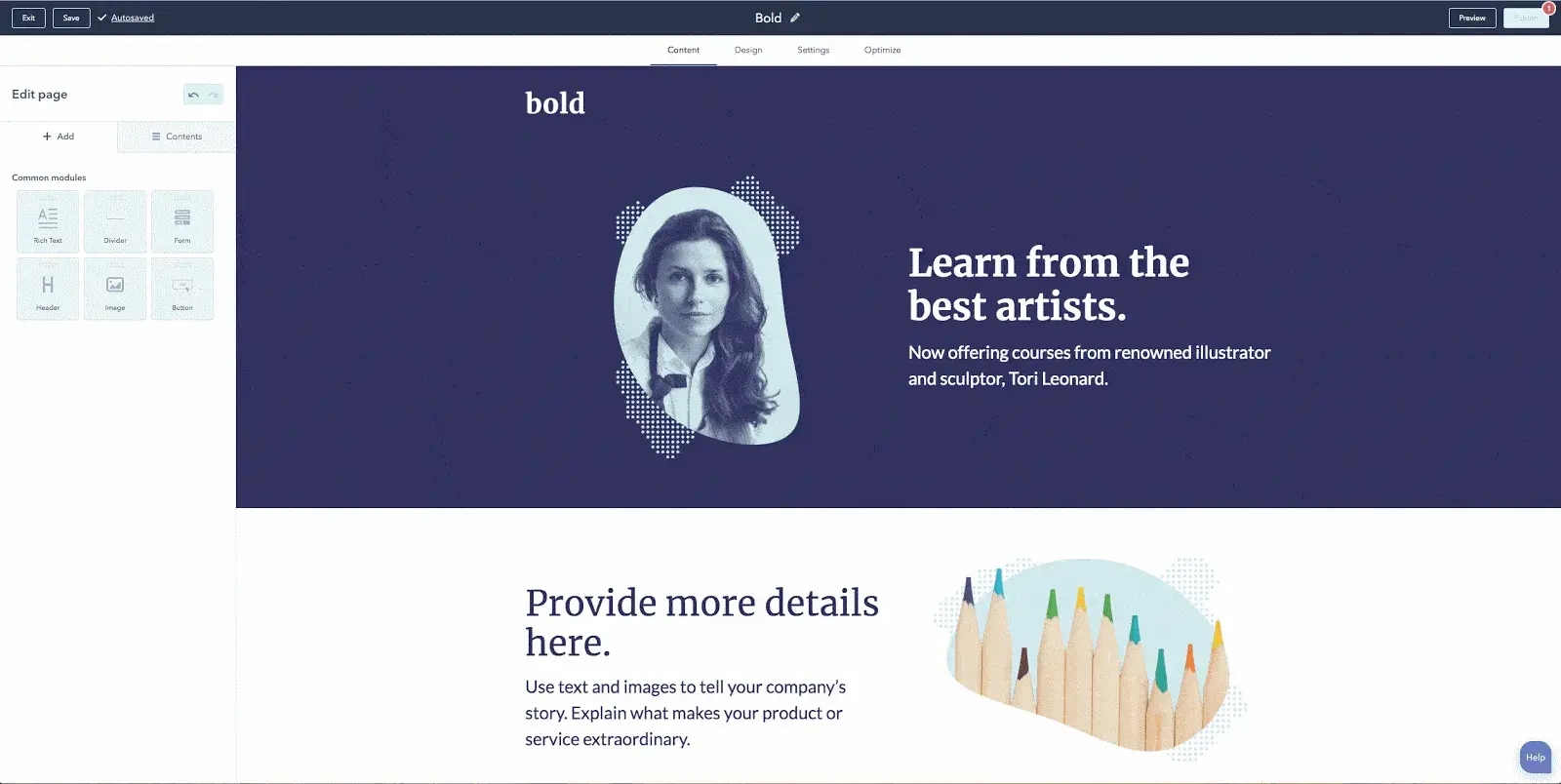
Get Started With the Free Drag-and-Drop Builder
Drag-and-drop page builders free up your developer’s time.
The best drag-and-drop website builders streamline the website design process for your entire organization. Because team members without coding experience can easily navigate a drag-and-drop builder, this frees up your dev team for other crucial tasks.
Without asking your developer to rearrange a page template so you can publish a page, developers can focus on more mission-critical growth projects that can move your business forward.
Drag-and-drop page builders help you improve the user experience.
Although everyone benefits from drag-and-drop page editing, the real benefactor is your customer. If you’re forced to build pages within a rigid template, your user experience ultimately suffers. Drag-and-drop page editing helps you create pages that give your website visitors the critical information they need to progress through the buyer’s journey.
Drag-and-drop page builders can let you leverage AI in web design.
With the growth of AI over recent years, many drag-and-drop builders have started offering AI tools to generate a website. Some tools can generate entire websites from a text prompt, while others give you tools to generate text, images, or code snippets to assist you in your efforts.
Personally, I don’t think full AI website generation is quite there yet, but AI can still be a really useful tool to speed up the process of creating a website. You can use it to generate a jumping-off point for your site or to help with copywriting and image creation.
As AI continues to improve, it might even reach the point where you can just use an AI-generated website “as is,” maybe with some minor tweaks that you make via the visual builder.
Best Overall Drag-and-Drop Page Builder
Choosing the best drag-and-drop page builder for you will depend on your unique situation, including your budget, feature needs, knowledge level, and so on.
However, if you’re looking for the best overall place to start, I think Content Hub is a great jumping-off point.
It lets you get up and running by choosing a premade theme or using the AI website builder. Then, you can customize your site via the visual, drag-and-drop page builder tool.
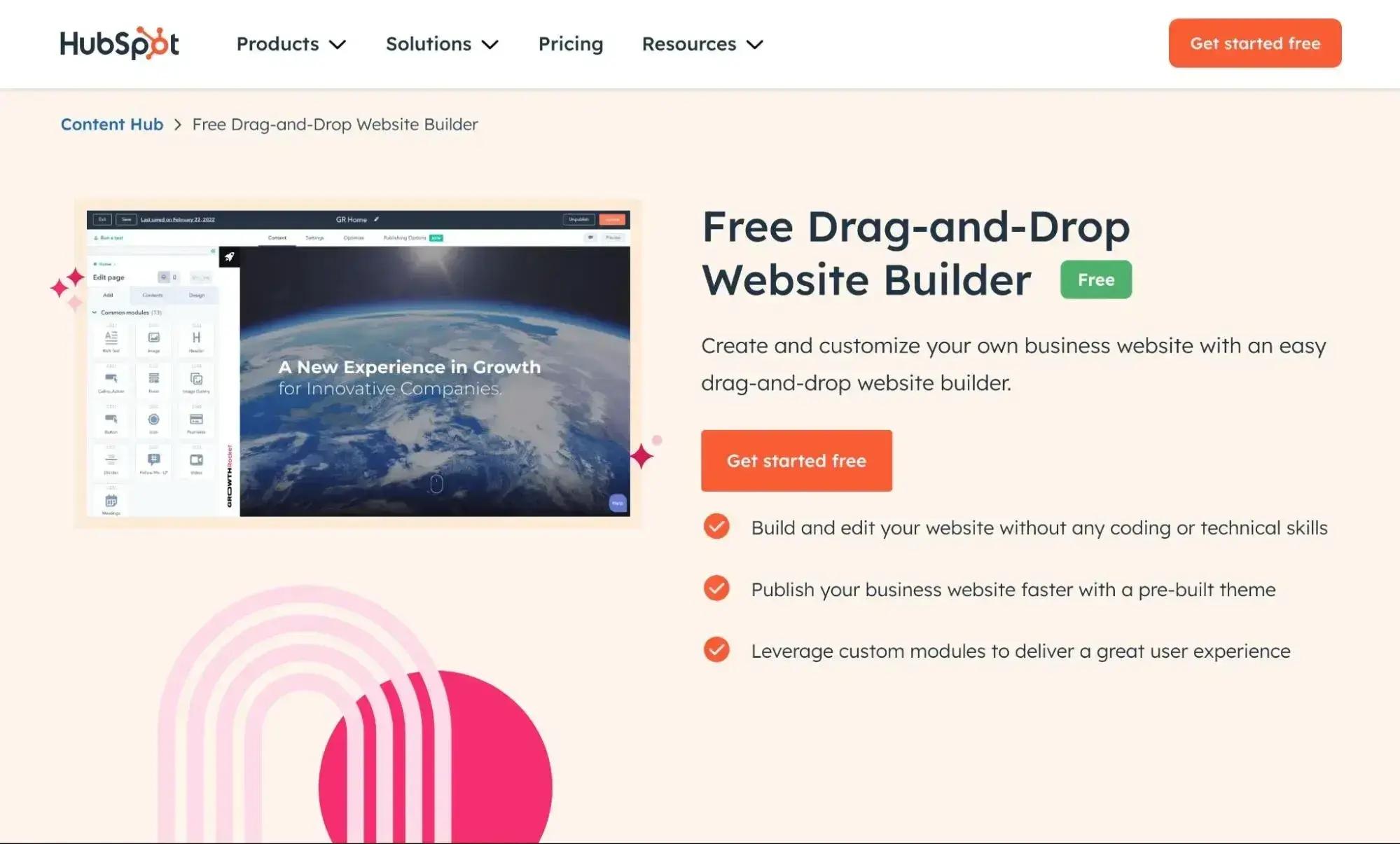
Beyond the design flexibility, Content Hub also gives you lots of marketing tools to help you make your site a success. These include a built-in customer relationship manager (CRM), email marketing, live chat, AI writing for content marketing, A/B testing, and plenty more.
Best Drag-and-Drop Website Builders
- Content Hub: Best Overall Drag-and-Drop Page Builder
- Elementor: Best WordPress Drag-and-Drop Page Builder
- Beaver Builder: Best Alternative Page Builder to Elementor
- Wix: Best Drag-and-Drop Page Builder for Beginners
- Squarespace: Best Drag-and-Drop Page Builder for Freelancers
- Webflow: Best for Exporting Code as Static HTML
- Divi: Best Premium WordPress Drag-and-Drop Page Builder
1. Content Hub: Best Overall Drag-and-Drop Page Builder
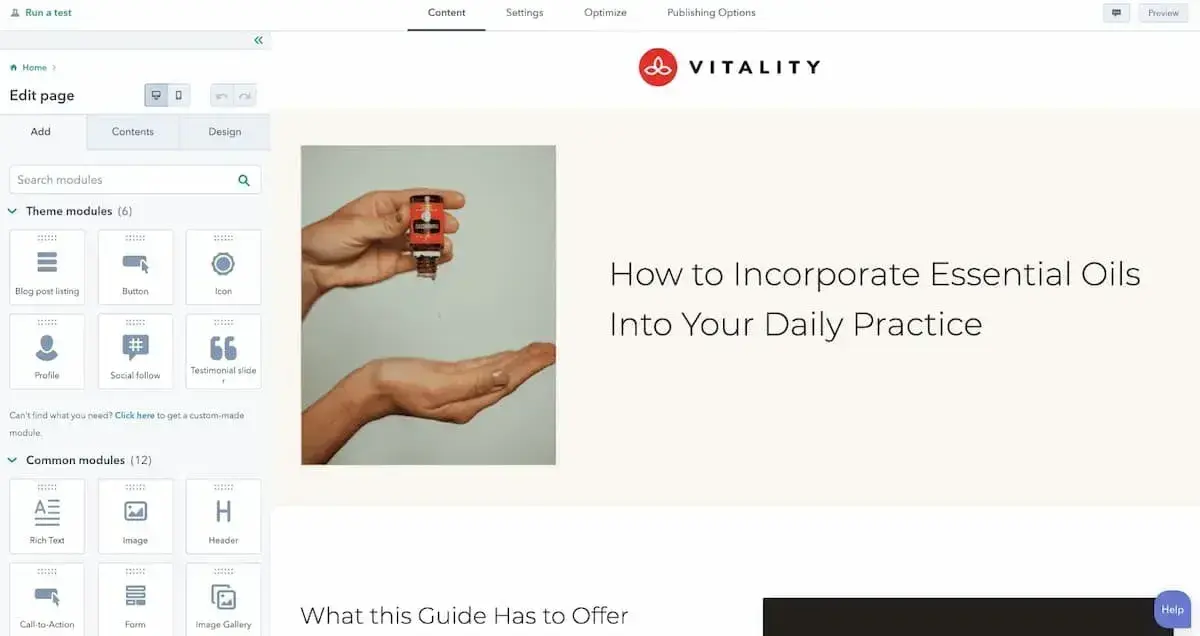
Get Started With Our Free Drag-and-Drop Builder
Content Hub offers an easy-to-use drag-and-drop page builder that has a tight integration with HubSpot’s other tools, such as the free HubSpot customer relationship manager (CRM).
You can get started by choosing a premade template, creating your own template from scratch, or even using AI to generate a template for you. I think this diversity of options can make it work well for people with all different technical backgrounds.
Regardless of how you get started, you’ll be able to manage everything using HubSpot’s builder interface. You can add content with premade elements and tweak everything using code-free styling rules.
What I think makes Content Hub a truly powerful page builder is that it also lets you leverage the information in your HubSpot CRM to create personalized experiences for visitors. While other page builders might offer some basic personalization tools, most of them won’t come anywhere near Content Hub for personalization.
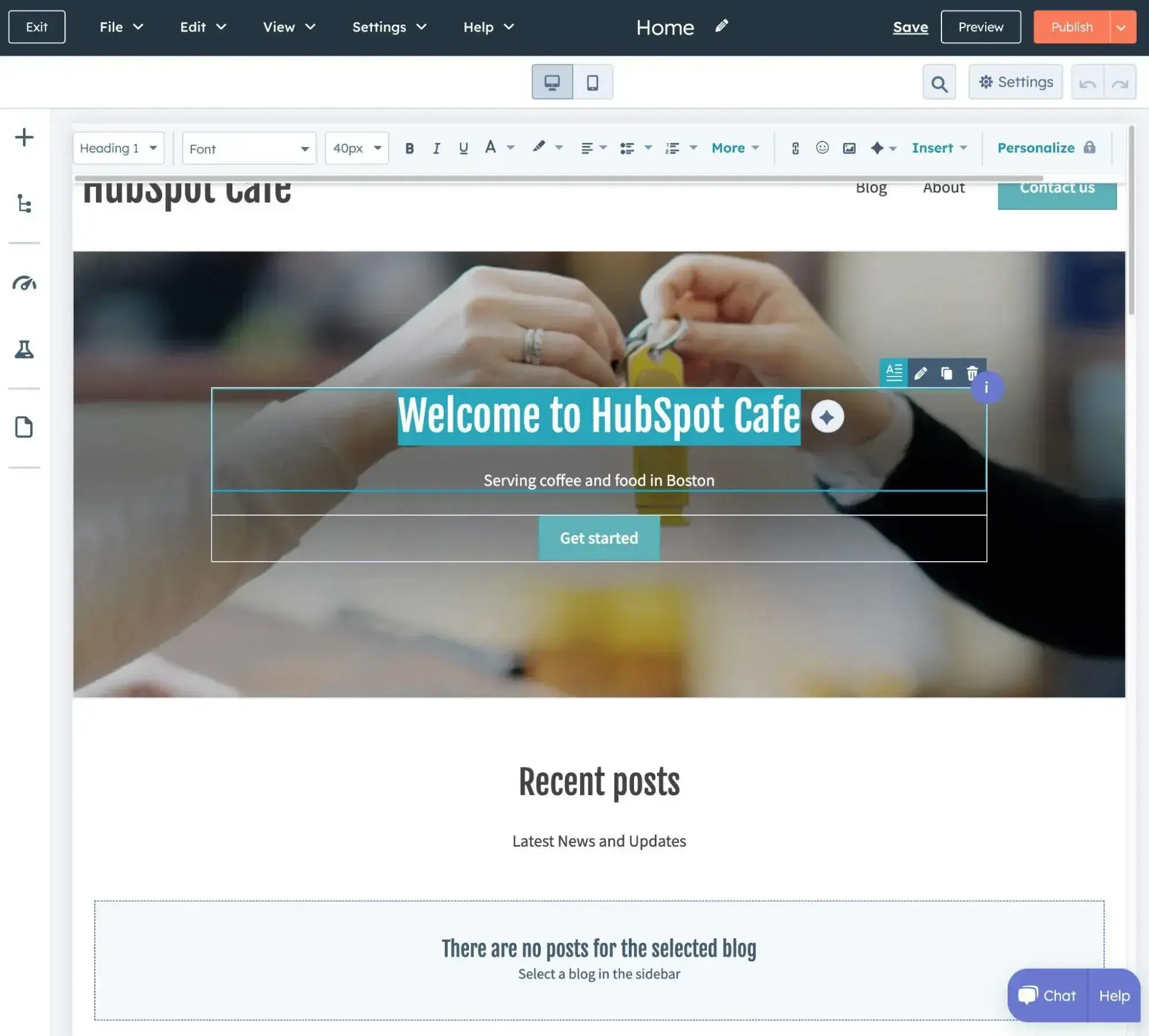
Because Content Hub is free to get started, you can give it a try to see how it fits into your overall digital content strategy.
My tip: Content Hub really excels when you want to use HubSpot’s personalization tools to create optimized experiences for your visitors. This can be incredibly helpful with marketing and sales, so I think it’s a big advantage for business-focused websites.
Pros
- You can build a site using the AI website builder or choose one of the pre-made templates and customize it yourself.
- Content Hub combines ease of use and power in an intuitive WYSIWYG editor.
- You can add custom modules to the drag-and-drop editor to give yourself even more flexibility when setting up your design.
- In addition to the official themes, there’s also a large library of third-party themes that you can easily use for your website. Currently, there are nearly 500 listings in the HubSpot Template Marketplace.
- Content Hub includes built-in AI tools for content creation, which can help you create landing page copy and/or blog posts.
- You get access to lots of built-in marketing tools, including the free HubSpot CRM, email marketing, optimization testing, and more.
- There’s also a built-in live chat tool that makes it easy to connect with your visitors.
Cons
- While you can find thousands of apps in the HubSpot App Marketplace, most of those are for the HubSpot CRM. The app selection for the Content Hub page builder is a little more limited.
- It’s probably not the best option if you want to include ecommerce functionality in your site.
- You can’t export your finished site as static HTML, so it’s not a good option if you’re just looking for an HTML drag-and-drop editor to help you generate static HTML websites. Basically, you’ll need to keep using the HubSpot CMS, which powers all of the useful dynamic functionality.
Pricing:
- Get started for free.
- $20 per seat/month (Starter).
- $500/month (Professional).
- $1,500/month (Enterprise).
When to use it:
Thanks to its built-in integration with the HubSpot CRM, I think HubSpot Content Hub is an especially great option if you want seamless access to a ton of marketing, sales, and service tools. While you can also use HubSpot with other builders, having everything already built into one package is really convenient.
2. Elementor: Best WordPress Drag-and-Drop Page Builder
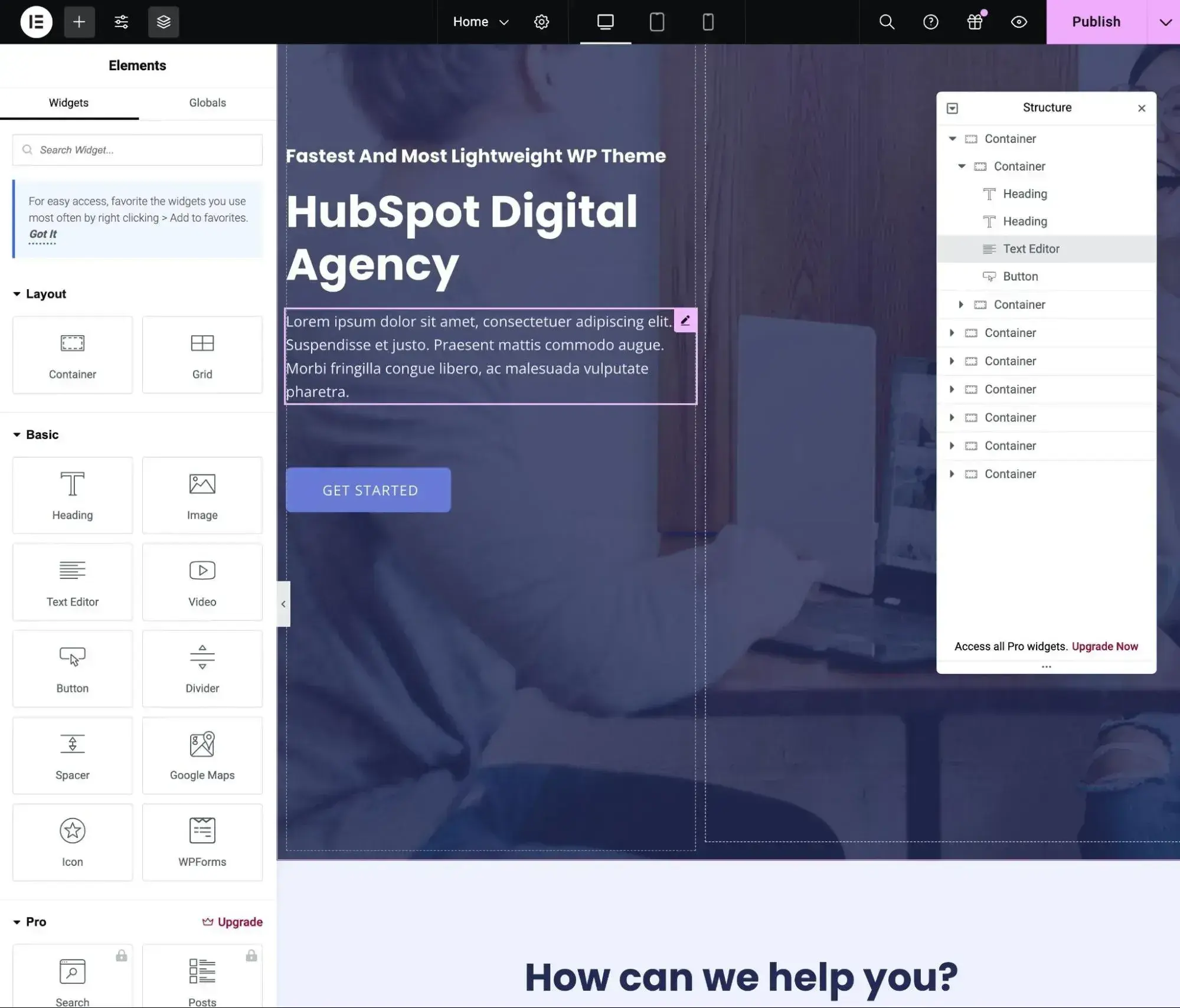
When it comes to the best drag-and-drop website builders that integrate with WordPress, Elementor is at the top of the list. It’s not just the most popular WordPress page builder plugin, but it’s also flat-out one of the most popular WordPress plugins in general.
It offers a 100% visual and drag-and-drop design interface to help you build everything, along with detailed design options and lots of advanced features like a form builder, pop-up builder, dynamic content, full WordPress theme building, and more.
You also get detailed design options to customize every element on your site without needing to use custom CSS (though you’re allowed to do that too, if you want).
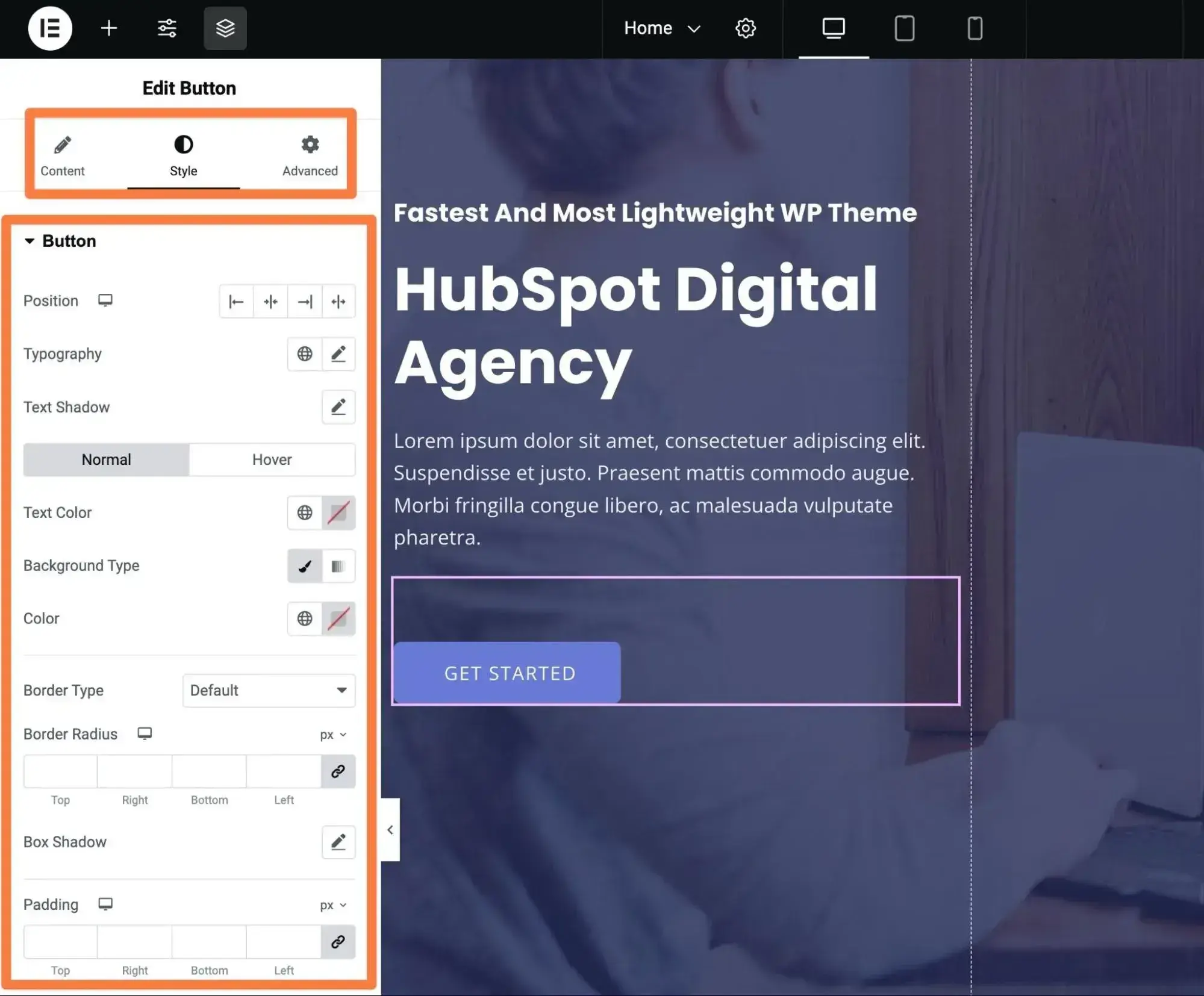
Elementor has also embraced AI, launching its own Elementor AI service to give you access to AI for text, images, and code snippets. While you can’t create entire page designs with AI yet, I still find this feature really helpful.
While I don’t use AI text or image generation very much, the AI code generation is super handy for generating custom CSS snippets when needed. Elementor also recently added the ability to use AI to generate entire container layouts.
One thing I really love about Elementor, though, is that its developers built it in a way that allows third-party developers to extend Elementor. This, combined with its popularity, has led to an absolutely massive marketplace of third-party plugins and templates that further extend Elementor.
The result is that Elementor lets you do pretty much anything without needing to code a custom solution, which I think is the true spirit of a drag-and-drop website builder.
In general, Elementor assumes that you’re going to continue using the WordPress CMS to power your dynamic website. However, if you’re searching for a static HTML drag-and-drop editor, I have a neat trick/workaround that lets you also use Elementor for that use case.
You can still create your designs with Elementor. But rather than serving up those designs via your WordPress site, you can export them as static HTML using a static site plugin like Simply Static. I think this can still make Elementor a good option, even if you just want a static HTML editor.
My Tip: Explore Elementor’s massive third-party extension and template marketplace to unlock lots of new functionality and designs. I think the huge marketplace of Elementor extensions is what truly sets it apart from other WordPress drag-and-drop editors.
Pros
- Elementor offers easy front-end editing and lots of design options.
- The builder interface includes true visual previews that look like exactly what your visitors will see.
- Elementor has useful built-in marketing tools like a form builder and pop-up builder.
- With Elementor Pro, you get deep support for dynamic data — for example, you can dynamically insert information from WordPress custom fields.
- With Elementor AI, you can access built-in AI tools for text, image, and code generation. You can now even generate entire containers. My hope is that one day, you’ll be able to create entire page layouts with Elementor AI.
- There’s a huge ecosystem of third-party Elementor add-ons and templates.
- While you can install Elementor on your own WordPress site, there’s also an all-in-one hosted version.
- You can also export your Elementor designs as static HTML using the Simply Static plugin.
- The free version is capable in its own right, though a lot of the best features require Elementor Pro.
Cons
- While Elementor has worked a lot to improve its performance, it can still add a bit of weight to the page (which affects performance). However, if you follow our website optimization checklist, you can still build a fast website.
- It’s not a standalone tool — Elementor requires free WordPress software to function. This isn’t necessarily a bad thing. I just want to make it clear that it’s not a standalone tool like some other page builders on this list.
- Elementor is a bit more expensive than other WordPress-based page builders.
- You won’t be able to use Pro features in new designs if your license ever expires. Your existing designs will keep working fine even without an active license — you just won’t be able to use the Pro features to build anything new.
Pricing:
- Free.
- Paid plans: $59/year (Essential – 1 site); $79/year (Advanced Solo – 1 site); $99/year (Advanced – 3 sites); $199/year (Expert – 25 sites); $399/year (Agency – 1,000 sites).
- If you want the all-in-one plans that include hosting, those start at $11.99 per month.
- If you want to use Elementor AI, that's an additional fee starting at $3.99 per month.
When to use it:
I recommend using Elementor if you’re already set on WordPress and you want the absolute most design options, features, and integrations. I just don’t think you can find another WordPress drag-and-drop editor that can beat Elementor when it comes to the amount of functionality on offer (especially when you include third-party extensions).
3. Beaver Builder: Best Alternative Page Builder to Elementor
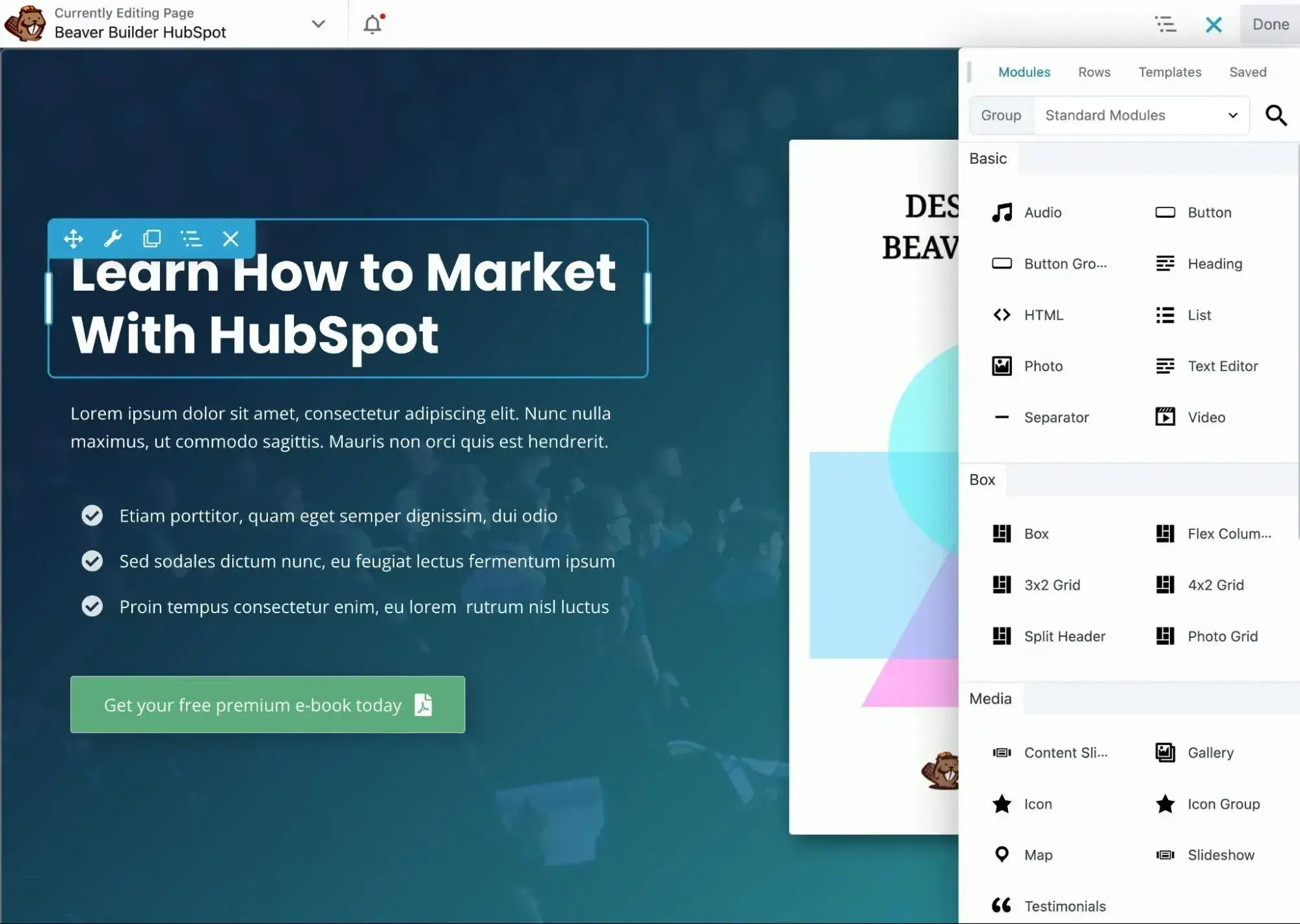
If you have a WordPress site and are seeking a page builder that isn’t Elementor, look no further than Beaver Builder. It lets you make tweaks to your site rapidly, and page editing is done on the front end, so the editor is truly a “what you see, is what you get” experience.
For a visual page builder plugin, Beaver Builder is actually pretty lightweight, in my experience. It’s one of the most performant page builder plugins that I’ve tested, so I think it can make a great option if you’re looking for a lightweight tool that won’t slow down your WordPress site.
It doesn’t give you quite as many bells and whistles as a page builder like Elementor, but it does nail the basics. I find that Beaver Builder is especially popular with “power users” who value having a lightweight foundation more than extra features.

For the most part, Beaver Builder assumes that you’re building a dynamic website powered by the WordPress CMS. However, as with Elementor, you’re also free to export your Beaver Builder designs as static HTML using a plugin like Simply Static. If you’re searching for a drag-and-drop editor for static HTML, I think Beaver Builder can still work well for you.
My tip: Don’t even bother trying the free version of Beaver Builder. I only recommend it if you’re willing to pay for the premium version.
Pros
- It has a true visual preview — you see what your visitors will see when you’re designing.
- Beaver Builder offers a really fast drag-and-drop interface — I almost never experience lag when building designs.
- It’s one of the most lightweight and performant WordPress-based page builder plugins.
- The drag-and-drop interface supports really easy column creation — just drag a column next to another.
- There’s a large ecosystem of third-party add-ons and templates (not as big as Elementor, but still more than most other tools).
- It has full support for theme building and dynamic content (with the developer’s Beaver Themer extension, which is included with paid licenses).
- You can export your designs as static HTML using a WordPress static site plugin.
- Beaver Builder offers an unlimited site license on the highest-tier plan (though it no longer supports unlimited sites on all tiers, as it did in the past).
Cons
- It doesn’t have as many advanced features and design options as some other tools. For example, there’s no pop-up builder or custom form builder like Elementor.
- It’s not a standalone tool — Beaver Builder requires the free WordPress software to function. Again, this isn’t a bad thing, it’s just something you need to understand.
- The free version is very limited — you pretty much need the paid version to build anything worthwhile.
- The core plugin doesn’t include as many templates as other drag-and-drop builders, though you can easily fix this because you can find so many third-party templates.
- Beaver Builder hasn’t added any AI tools yet, which could be a negative if you want to use AI to help with your designs. I don’t personally care about this because I’m fine using third-party AI tools, but you might.
Pricing:
- Free (Lite Version).
- $89/year (Starter – 1 site).
- $299/year (Professional – 50 sites).
- $546/year (Unlimited – Unlimited sites).
When to use it:
I think you should consider Beaver Builder if you just want a lightweight, performant drag-and-drop editor for WordPress. While it doesn’t have nearly as many bells and whistles as Elementor, Beaver Builder nails the basic functionality that most people need in a drag-and-drop page builder.
4. Wix: Best Drag-and-Drop Page Builder for Beginners
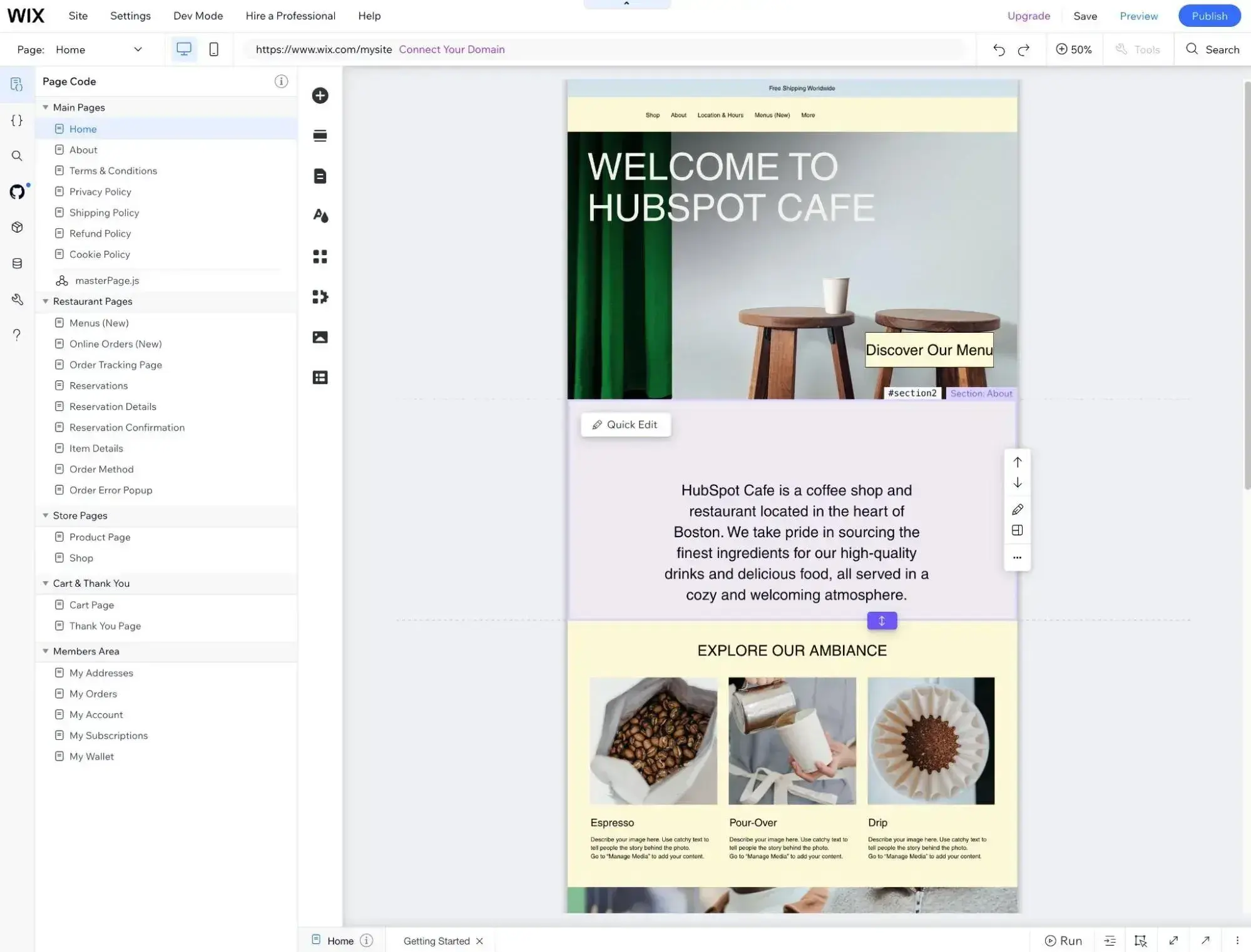
Wix is one of the most popular web page builders available. Its drag-and-drop interface doesn’t rely on columns like many page builders. Instead, the editing experience is very similar to editing a Google Slide, which is ideal for those who don’t want to tackle a learning curve or have limited technical experience.
Out of the box, Wix provides you with a long list of modules and styling options so you can quickly create the exact website you’re looking for. For more advanced users, Wix also gives you some access to your site’s underlying code via tools like Velo.
Beyond the built-in features, I appreciate that Wix also offers a large library of official and third-party extensions that you can use to add new features and integrations to your site.
Wix has also really embraced AI, even giving you the option to generate your site using AI. If you’re searching for an AI page builder tool, I think Wix is one of the best options for you to consider.
With Wix’s AI website builder, you’ll create your sites by adding some simple text prompts instead of choosing a premade template. Wix will then use its AI tools to generate your entire website, including the design, text, and images.
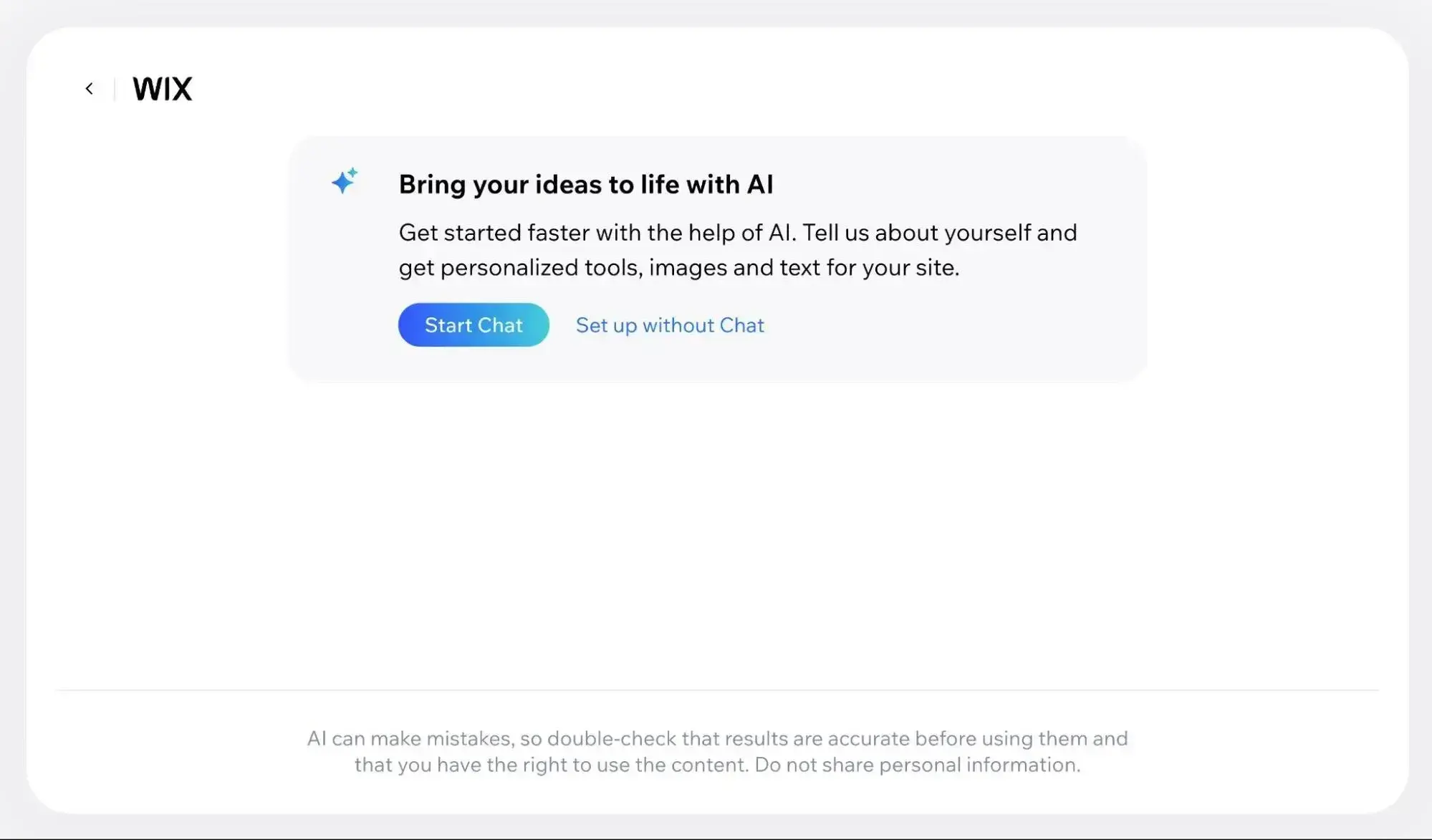
One thing that I don’t like about Wix, though, is its lock-in. Wix doesn’t let you export static HTML, and it also just makes it a bit annoying to export your site’s content in general. This means that you’ll need to do a lot of manual work if you ever want to change from Wix to a different website builder.
I don’t think this should stop you from using Wix by any means. I just encourage you to explore all of the options before choosing Wix because you won’t be able to easily switch in the future.
My tip: One of the unique things about Wix is that, even though it’s a hosted website builder, it still has a pretty robust app marketplace. I encourage you to explore these apps if you decide to use Wix.
Pros
- Wix has really embraced AI, and it’s one of the best AI website builders out there.
- You have multiple options for launching a site — you can choose a template and customize it or let Wix’s AI generate a site for you.
- The design interface is truly visual and 100% drag-and-drop, which gives you lots of flexibility.
- You get tons of modules and design options to customize your site.
- Even though it’s a hosted website builder, Wix still has a pretty large marketplace of third-party apps.
- Wix offers built-in tools for ecommerce, membership sites, appointments, and more.
- If you want more technical access, Wix’s Velo offering gives you a decent amount of flexibility.
Cons
- If you ever want to change platforms, Wix makes it difficult to fully export your site’s content, which adds a degree of “lock-in.”
- The Wix interface can feel a little bit overwhelming at first because there are so many options.
- Wix changed its pricing in 2023 and it can now be a bit more expensive than some other hosted website builders, depending on the specific features that you need.
- You can’t change your Wix template after you launch your site. If you ever want to change the base design, you need to start over from scratch.
Pricing:
- Free (with Wix subdomain).
- Light ($17/month when paid annually).
- Core ($29/month when paid annually).
- Business ($36/month when paid annually).
- Business Elite ($159/month when paid annually).
When to use it:
I think Wix is the best all-around SaaS website builder. While there are other tools that beat it in specialized areas, Wix does everything at least pretty well. Wix has also really embraced AI tools, which I think will continue to improve going forward.
5. Squarespace: Best Drag-and-Drop Page Builder for Freelancers
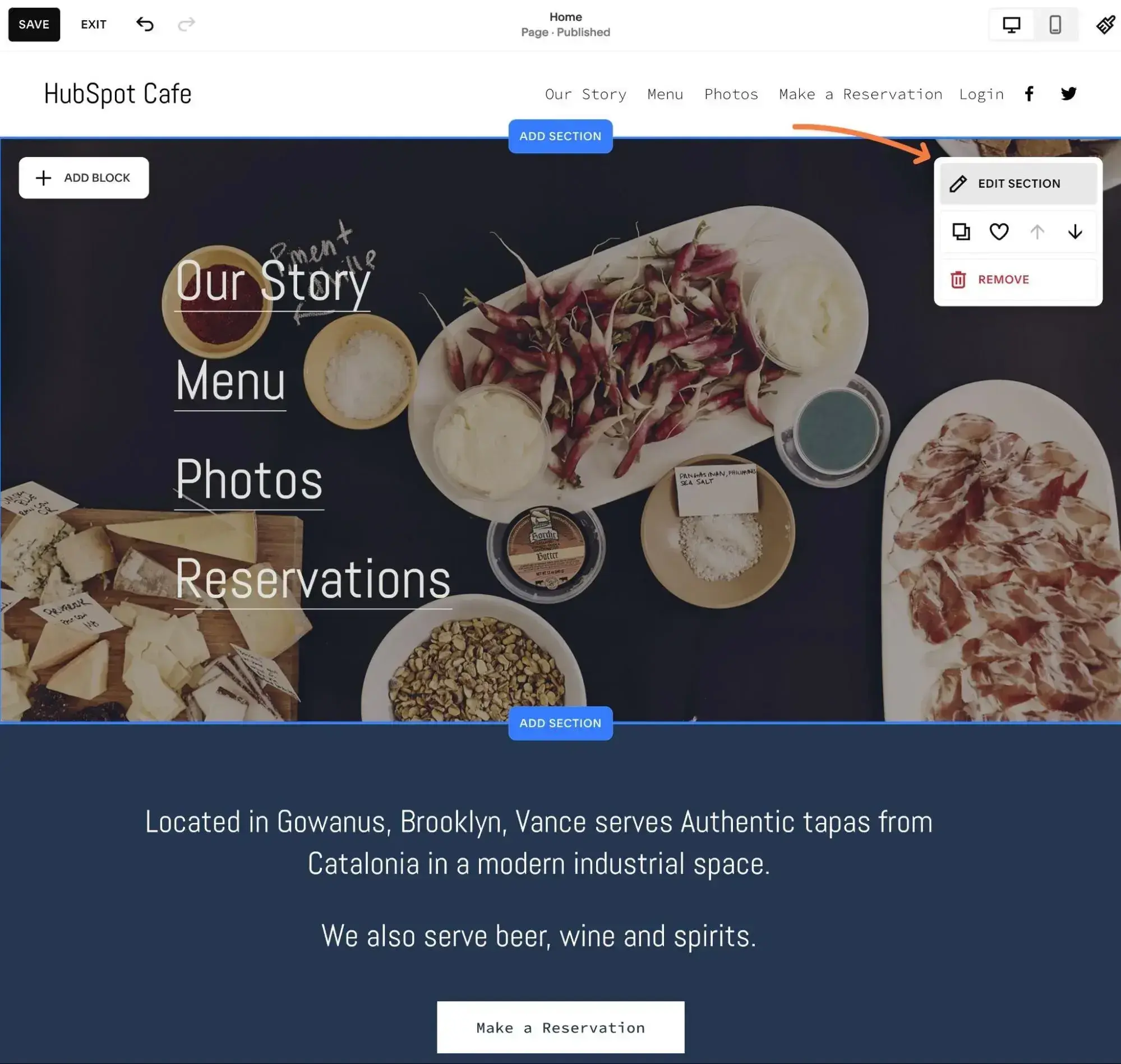
Squarespace is another hosted page builder tool that gives you full control over your website. It has a long list of templates you can use to start your website in no time. Or, you can even let Squarespace’s Blueprint AI service design the site for you, which is a great feature if you’re in the market for an AI website builder.
Plus, there are plenty of premade, visually appealing modules you can place wherever you prefer on your website. It’s as easy as the click of a button — no code necessary.
I absolutely love Squarespace’s new Fluid Engine, too. Unlike some other page builders, the Fluid Engine doesn’t limit you to dragging elements inside of a preset grid. Instead, you can literally drag an element anywhere on your page, which gives you pixel-perfect control.
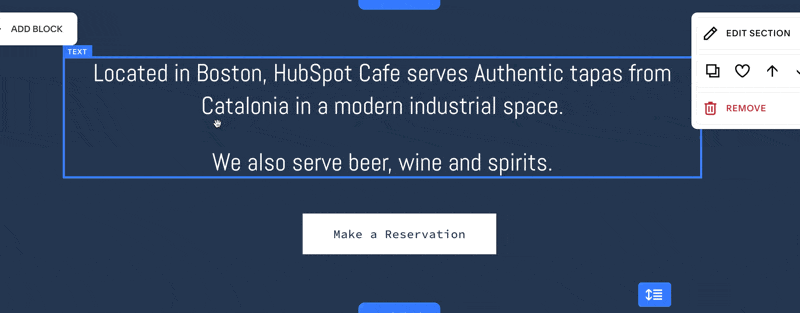
Much like other page builders in this list, Squarespace doesn’t have many options for developers to customize your site, but it provides you with a long list of web elements that you can use to build your web pages.
One thing I don’t like about Squarespace, though, is that it doesn’t really have a third-party extension marketplace. While this won’t affect most sites, it does mean you can’t access as many integrations.
Squarespace also doesn’t give you full access to the underlying HTML of your website unless you pay for the Business or Commerce plans (which give you access to the Squarespace Developer Platform). On the Personal plan, your only option is to add custom code in the code block — you can’t actually edit the full HTML on those plans.
My tip: If you hate being limited by preset grids when using an HTML drag-and-drop editor, I think that you’ll really love Squarespace’s Fluid Engine. I know that I do!
Pros
- You have multiple options for launching a site — you can choose a template and customize it or let Squarespace’s Blueprint AI tool generate it for you.
- Squarespace’s Fluid Engine gives you a truly free-form drag-and-drop design experience, whereas many other drag-and-drop tools still make you adhere to a basic grid system.
- The Squarespace interface is clean and minimal — I find it to be very easy to use.
- Squarespace offers built-in tools for ecommerce, appointments, forms, and more.
- Unlike Wix, Squarespace makes it fairly easy to export all of your site’s data.
Cons
- Squarespace doesn’t offer as many templates as some other tools, though the templates do generally look great.
- While Squarespace does now offer some extensions, the collection is still very limited when compared to other tools.
- You can’t fully access your site’s underlying HTML on the Personal plan, which you might not like if you’re specifically looking for an HTML editor.
- Squarespace adds an extra 3% transaction fee for ecommerce transactions on the Business plan — you need to pay for one of the Commerce plans to remove this fee.
Pricing:
- Personal ($16/month when paid annually).
- Business ($23/month when paid annually).
- Basic Commerce ($28/month when paid annually).
- Advanced Commerce ($52/month when paid annually).
When to use it:
I think Squarespace is a great option if you like the aesthetic of Squarespace’s templates and the free-form Fluid Engine editing style. While Squarespace doesn’t offer quite as much functionality as other tools, it nails the basics of creating a beautiful website quite well. It also still includes essential features such as online selling, if you need those.
6. Webflow: Best for Exporting Code as Static HTML
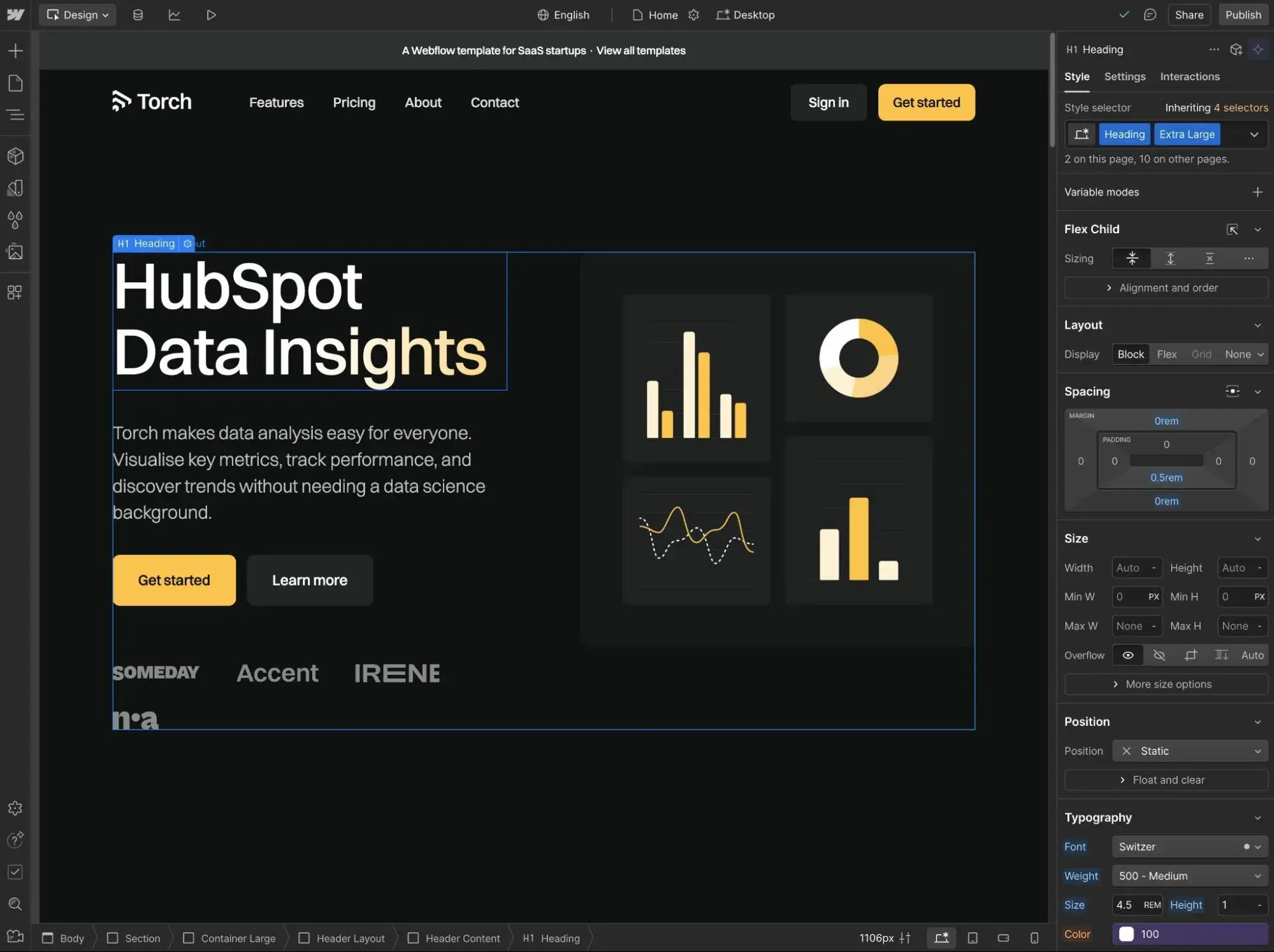
Webflow is a drag-and-drop builder that offers a marriage of visual design with actual code editing.
While the drag-and-drop Webflow editor lets you set up everything without code, it still uses “real” code principles such as divs, Flexbox, etc. It also lets you dig in and edit the code directly, which I think is something that advanced users will really appreciate.
However, the downside of having all these real-world CSS options is that I think the Webflow interface can feel a little overwhelming sometimes. For example, look at all the nitty-gritty options in the sidebar on the right in my screenshot below.
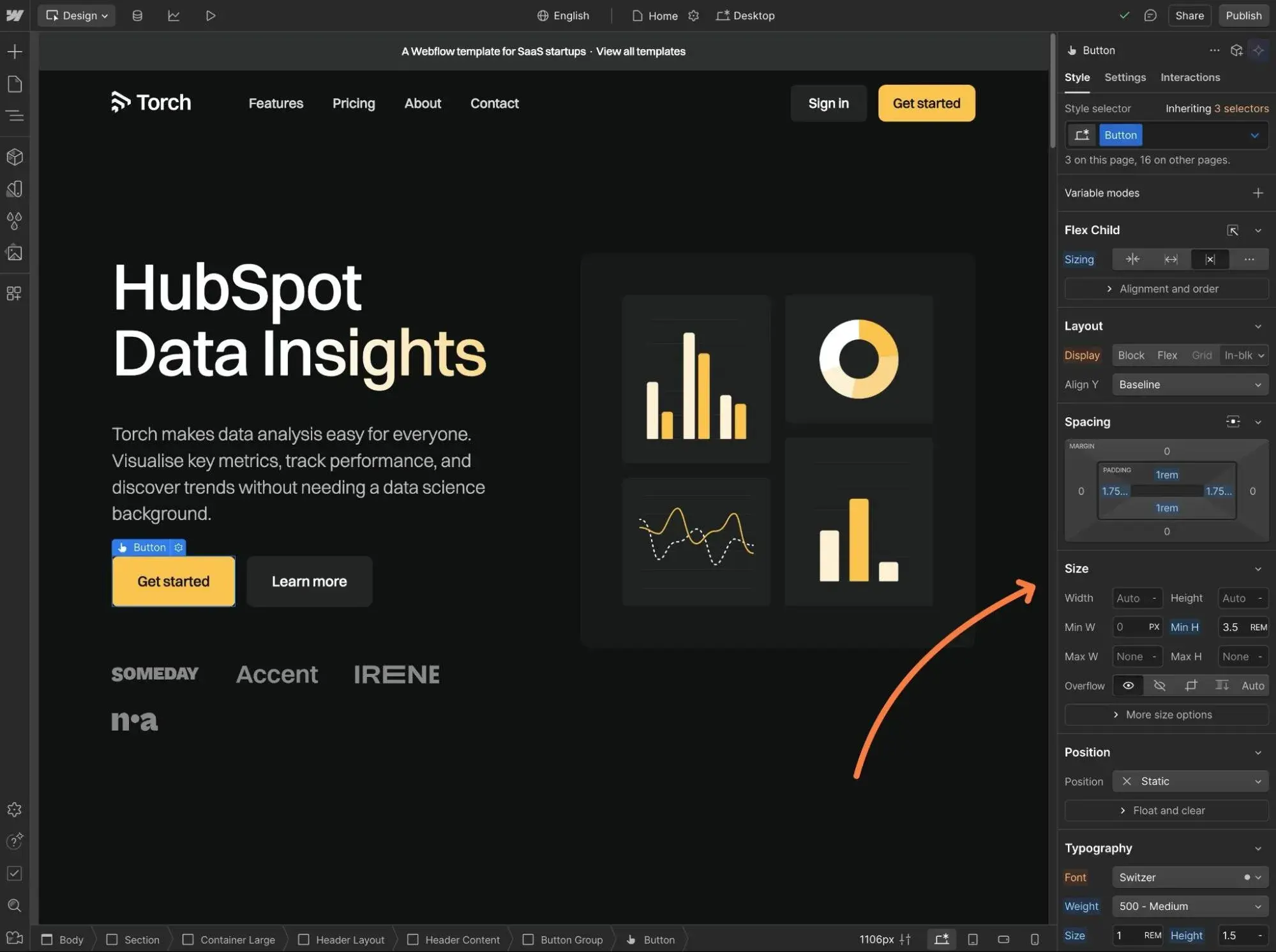
If you want to build more dynamic websites, Webflow also has its own proprietary CMS that you can use to build content sites, online stores, and more.
One of the things that I like the most about Webflow is that it lets you export your site as plain code (HTML, CSS, and JavaScript). Most of the other drag-and-drop page builder tools require you to keep using their proprietary systems no matter what.
While you will need to keep using Webflow if you want to rely on the Webflow CMS features, you’re totally free to export your site as static HTML if you don’t need the CMS functionality.
If you’re searching for an HTML drag-and-drop editor, I think this should put Webflow near the top of your list.
My tip: Webflow is one of the top options if you want to export your site as plain HTML. At the same time, Webflow's CMS gives you all the functionality that you need to build dynamic websites too. You will need a paid plan if you want to use Webflow’s official export to HTML functionality, but third-party tools like ExFlow can offer similar functionality on the free plan (though they can be a little buggy sometimes, in my experience).
Pros
- Webflow’s visual interface still uses “real” code terminology, which should make developers and designers feel right at home.
- For technical users, you can still access the HTML, CSS, and JavaScript directly.
- Webflow still creates clean, semantic HTML, which is something a lot of other visual builders can struggle with.
- You can export your finished design as static HTML that you can use with any hosting, which makes it a great option if you’re looking for a visual HTML editor. You will not be able to use the Webflow CMS functionality when you do this, though.
- It gives you the option to use the built-in CMS if you want to build dynamic websites.
- If you create website mockups with Figma, you can convert those designs directly into working websites with Webflow.
Cons
- While I personally like that Webflow uses “real” code terminology, non-technical users or beginners might feel overwhelmed by this.
- Webflow’s localization features are very expensive, so I don’t recommend using it if you want to create a multilingual website. You also can’t export localized pages as static HTML anyway, which is another bummer.
- Webflow’s pricing increases based on the number of pages and CMS items (e.g., blog posts) on your website, which I find to be a little annoying. This could be an issue if your website has a ton of content.
- While there are thousands of Webflow templates available, most of them cost money and the collection of free templates is a lot more limited. For example, I found that only ~85 of the 6,000 templates are free.
Pricing:
- Free (webflow.io subdomain and no HTML export).
- Basic ($14/month when paid annually).
- CMS ($23/month when paid annually).
- Business ($39/month when paid annually).
- Enterprise (talk to sales).
When to use it:
I think Webflow is the best option for more advanced users who are familiar with at least the basics of CSS and want a visual builder that sticks closer to how code actually works. For example, Webflow still uses terms like “div,” which should make designers/developers feel right at home.
It also has a built-in feature to export your site’s raw HTML, which makes it a great option if you want an HTML drag-and-drop editor.
7. Divi: Best Premium WordPress Drag-and-Drop Page Builder
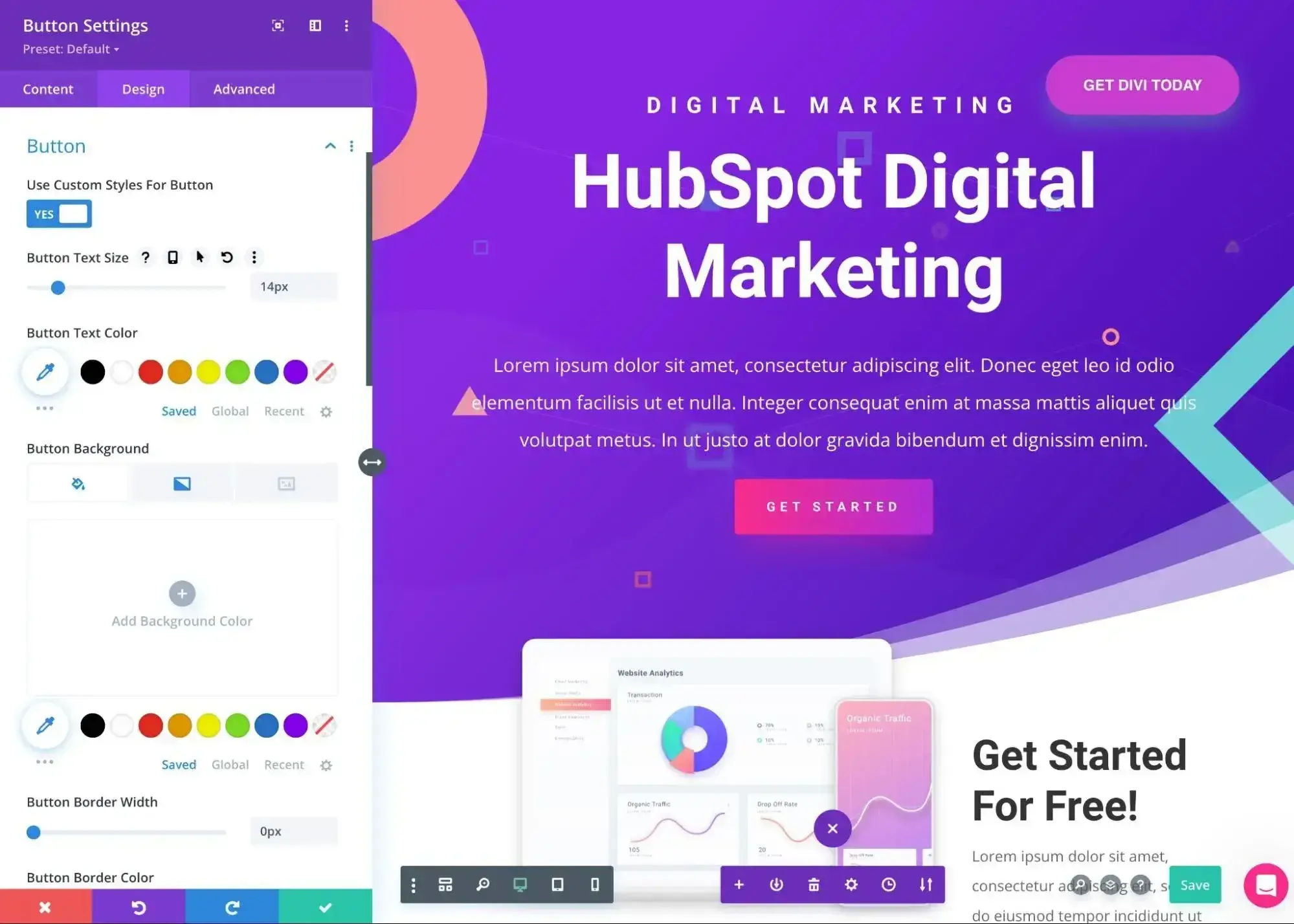
Divi is another popular page builder you can use to craft your WordPress site. With Divi, you can make edits in a WYSIWYG page editor and drag and drop custom elements to meet your needs.
If you install Divi, you can make custom design changes, and developers can also combine Divi’s visual design controls with their own custom CSS. It also provides a number of filters and design options to make designing a web page more of a creative process.
Divi has also embraced AI with its new Divi AI service, which lets you use AI to generate text, images, code snippets, and Divi layouts.
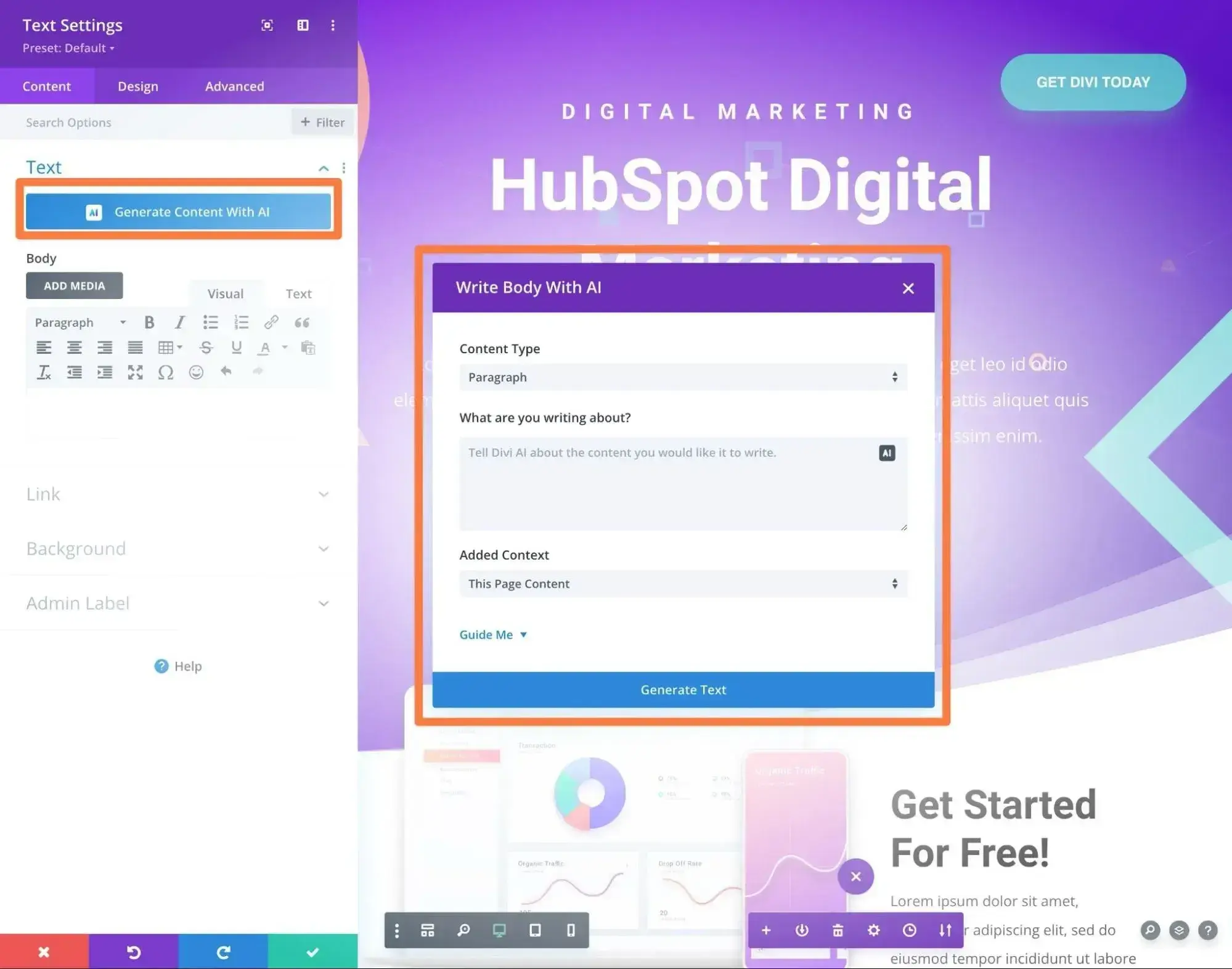
Because Beaver Builder no longer offers unlimited site usage on all of its plans, Divi is now the cheapest option on this list if you need support for unlimited sites. For example, if you’re looking for a page builder to build client websites, Divi will be the cheapest option on this list.
Divi also offers a lifetime license, which is another unique pricing detail that can make Divi very affordable over the long term.
Basically, if cost is one of your primary concerns, I think that Divi can be one of the cheapest drag-and-drop builders over the long term.
Pros
- You can use it as a standalone WordPress plugin (Divi Builder plugin) or an integrated theme (Divi theme).
- It includes built-in A/B testing, which is an advanced marketing feature that most other page builders don’t offer.
- The Divi AI service lets you use AI to generate text, images, code snippets, and even Divi layouts.
- It offers full WordPress theme-building support, along with support for dynamic data insertion.
- There’s a large marketplace for third-party Divi extensions and layouts, which gives you lots of flexibility when adding new features and integrations.
- Divi offers unlimited site usage on all plans, along with a one-time payment lifetime plan. These two things can make it very cost-effective over the long term, especially if you’re building multiple websites.
Cons
- Personally, I don’t find Divi’s interface to be as easy to use as other WordPress page builders like Elementor or Beaver Builder. You might feel differently, though, so I encourage you to test it for yourself.
- Divi can add a bit of weight to the page, which can affect performance. However, the Divi team has really worked on improving this so the performance drag is now pretty minimal (whereas it was a lot more prior to 2022 or so).
- There’s no free version.
Pricing:
- $89/year (Yearly Access).
- $249 one-time fee.
When to use it:
I mainly recommend Divi if you need an unlimited-site drag-and-drop page builder for WordPress. I personally prefer Elementor and Beaver Builder solely on functionality, but Divi is hard to beat from a price/value perspective because of its lifetime license option and unlimited usage.
Choosing a Drag-and-Drop Page Builder
I love drag-and-drop page builders for their code-free flexibility, but there are now so many options in the market that I think it’s really tough to choose the right tool.
By highlighting the pros, cons, and use cases for each tool, I hope that I’ve given you the ability to choose the right HTML drag-and-drop editor for your next project.
Finally, if you need some inspiration for what to build with your new drag and drop page builder, check out our free website design inspiration lookbook.
Editor's note: This post was originally published in June 2020 and has been updated for comprehensiveness.
HTML







-2.webp)
![14 Stunning HTML Websites [+ How They Work]](https://53.fs1.hubspotusercontent-na1.net/hubfs/53/Copy%20of%20Featured%20Image%20Template%20Backgrounds-1.webp)


![How to Embed Google Map in HTML [Step-By-Step Guide]](https://53.fs1.hubspotusercontent-na1.net/hubfs/53/Google%20Drive%20Integration/How%20to%20Embed%20Google%20Map%20in%20HTML%20%5BStep-By-Step%20Guide%5D-2.jpeg)
